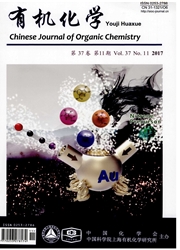

 中文摘要:
中文摘要:
采用紫外跟踪分离和波谱鉴定的方法,从海洋异壁放线菌(Actinoalloteichus cyanogriseus WH1-2216-6)的发酵产物中分离鉴定了6个5,5,6-多环含特特拉姆酸大环内酰胺(PTMs)类天然产物:16-hydroxymaltophilin(1)、dihydromaltophilin(2)、4-deoxydihydromaltophilin(3)、maltophilin(4)、xanthobaccin C(5)和FI-2(6),其中1为新化合物.评价了化合物1-5对人正常肝细胞L-02及人癌细胞A549、MCF-7、Jurkat、BXPC-3、HCT-116、PANC-1和K562的细胞毒活性,结果表明:化合物1-5对上述人癌细胞具有细胞毒活性,其半数抑制浓度(IC50)为0.1-9.7μmol·L-1;新化合物1对L-02的毒性较低,但对Jurkat、HCT-116和BXPC-3的选择指数(SI)分别高达31.5、41.1和52.4.除化合物2和3对A549和MCF-7的肿瘤细胞毒活性外,其余的肿瘤细胞毒活性是首次报道.还测试了化合物1-6的抗烟曲霉活性,发现化合物2和4的活性较好,其最小抑菌浓度(MIC)分别为3.04和6.12μmol·L-1,这是首次发现5,5,6-PTMs类化合物具有抗烟曲霉活性.
 英文摘要:
英文摘要:
From the fermentation broth of the marine-derived Actinoalloteichus cyanogriseus WH1-2216-6, a new 5,5,6-polycyclic tetramate macrolactam(PTM) named 16-hydroxymaltophilin(1) was isolated and identified along with five known analouges, dihydromaltophilin(2), 4-deoxydihydromaltophilin(3), maltophilin(4), xanthobaccin C(5) and FI-2(6), by means of UV-guided isolation as well as the spectroscopic identification. The cytotoxicities of compounds 1-5 were tested against the human normal hepatic cell line(L-02) and the seven human cancer cell lines, A549, MCF-7, Jurkat, BXPC-3, HCT-116, PANC-1 and K562. The results showed that compounds 1-5 were active against the above human cancer cell lines with the IC50 values of 0.1-9.7 μmol·L-1, among which the new compound 1 was the lowest toxic to L-02 cell and the most selective to Jurkat, HCT-116 and BXPC-3 cells with the selection index(SI) of 31.5, 41.4 and 52.4, respectively. The antifungal activities of 1-6 against Aspergillus fumigatus AF293 were also tested by two-fold dilution method. Compounds 2 and 4were active against A. fumigatus AF293 with the minimum inhibitory concentration(MIC) values of 3.04 and 6.12 μmol·L-1, respectively. To the best of our knowledge, this is the first time to report the antifungal activity of 5,5,6-PTMs against A. fumigatus AF293. Apart from the cytotoxicity of compounds 2 and 3 against A549 and MCF-7 tumor cells lines, the other cytotoxicities were reported here for the first time, indicating the potential use of PTMs as the antitumor and antifungal lead compounds against A. fumigatus.
 同期刊论文项目
同期刊论文项目
 同项目期刊论文
同项目期刊论文
 期刊信息
期刊信息
